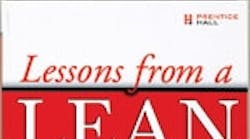Chris Ortiz relates a story that is commonplace in manufacturing organizations attempting a lean implementation. Ortiz, owner of lean consultancy firm Kaizen Assembly, begins "Lessons From a Lean Consultant" with a narrative about a former employer that struggled in the kaizen process -- the brainstorming and problem-solving sessions essential to driving improvements through lean.
The company, which Ortiz calls "X-Corp.," made a major mistake when it never provided formal training to the continuous-improvement teams on how kaizen events are conducted. The result was a dysfunctional mess that left employees distressed and drove Ortiz -- who was hired by the company as a senior lean manufacturing engineer -- to quit.
"It was apparent we needed a comprehensive company kaizen program," he writes. "Unfortunately, on this journey, communication, scheduling, team member selection and the upfront planning were minimal."
Midway through the book, Ortiz provides insight into how teams should be selected, calling it "probably the most critical aspect of planning kaizen events." He suggests that at least four weeks before a scheduled kaizen event that senior leadership make a tentative list of possible team members so managers can begin preparing for their absence and then finalizing the list two weeks later to ensure personal or family restrictions are accommodated.
Potential team members should include:
Ortiz also makes suggestions for selecting kaizen team leaders. The key characteristics of successful kaizen leaders include past participation in at least three kaizen events, completion of project management training, creation of a budget and schedule for a previous project, experience leading a team environment and the ability to work well under pressure.
Among the other lean-related topics tackled by Ortiz in the book are training programs, leadership skills and strategy development. For the novice lean practitioner, Ortiz wraps up with an ever-valuable glossary of terms from "5s" methodology to "takt time."
See Also



